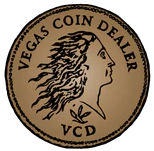The Mint of The United States Denver silver ingots
The Mint of The United States Denver silver “Ruler Ingot” is pictured below;
Length 13 inch
Width 1” 7/16th inches
Thickness 7/16th inch
Hallmark
Width 13/16th inch
Height 1/2 inch
Number 6
Weight 40.2 oz
Marked Purity 999.75
This “Denver Ruler Ingot”, discussed here, is only the second known example of a United States Mint Denver Assay Silver Ingot. The other known Denver Assay Silver specimen is discussed below as is the one other “Ruler Ingot” known which is a Mint of the United States Philadelphia piece. However, with that being said, they are far from equal as the Denver ingot is in a known total population of two (2) while there are at least fifty-five (55) Philadelphia ingots known as noted in Ken Conaway’s registry.
Being this specimen is not only a rare style “Ruler Ingot” and in addition a silver ingot with a United States Denver Hallmark (government mintmark) shown below. This museum quality specimen is virtually the “Holy Grail” of known Mint of the United States ingots.




Some historians would classify the Mint of the United States Denver “Ruler Ingot” as a Strip Cast Sheared Silver Ingot but according to Ken Conaway and Steve Austin it is more likely actual bar stock rolling method of production.
The first and other known example of a Denver Mint silver ingot was placed by Kagin's Incorporated in the United States Government Silver Ingot Collection of Ken Conaway.
Since Ken’s acquisition, he discovered that his “ingot was first owned by Dr. Philip W. Whiteley from Denver where it was confirmed by him to be the only Denver Mint silver ingot privately held. From Dr. Whiteley, the Mint of The United States Denver silver ingot was sold to Clarence Criswell where it was held until the 1984 ANA Convention Auction by Kurt R. Kruger in Detroit, Michigan”. (Ken Conaway)
Mint Of The United States Denver silver ingot is pictured below; no serial number, 11.64 ozs 999 3/4 Fine, ex- Dr. Philip W. Whiteley collection, ex- Clarence Criswell collection. The hallmark is identical to those found on Mint of The United States Denver gold ingots dated between 1948 and 1954. (Ken Conaway)

The Ken Conaway Denver Specimen shown above.

The Mint at Denver opened for business in late 1863 as a United States Assay Office. It was established the year earlier by an Act of Congress on April 21, 1862. Located at 16th and Market Streets and acquired by the government for $25,000 from Clark, Gruber and Company. During the Pikes Peak Gold Rush, the men of Clark, Gruber and Company coined gold and gold dust brought from the gold rich areas by the local miners. For almost three years, they minted gold coins (1860–61) and ingots (1862).
While the Colorado Gold Rush was not as famous as the California Gold Rush of 1859 Colorado produced significant levels of gold. To assay the gold into trusted coinage, Clark, Gruber & Company opened a facility in Denver in the late 1850s in which they purchased raw gold, then minted it into coins or brokered/sold the gold to the United States Federal government. In the first three years of operation, Clark, Gruber purchased 77,000 ounces of gold and struck $594,305 worth of privately issued coinage. The Clark, Gruber coins were not legal tender, however the coins were trusted due to their reputation.
Clark, Gruber & Company were formally purchased by the US Treasury in 1863. Unlike Clark, Gruber and Company, the Denver Mint (Assay) office performed no coinage of gold as originally planned. One unfortunate reason given by the Director of the Mint for the lack of coin production from Denver was, “… the hostility of the Indian tribes along the routes, doubtless instigated by rebel emissaries (there being a Civil War) and bad white men.”
Gold of various forms were accepted by the Assay Office from local and regional miners for melting, assaying, and stamping of cast gold bars:
The bars were then returned to the depositors as imparted bars stamped with the weight and fineness of the gold. A high percentage of the gold came from the rich beds of placer gold found in the streams first discovered in 1858, the same year the city of Denver was founded. When the gold of the streams was panned and depleted the preferred technique became lode mining, which exposed veins of ore with high percentage yields of gold and silver. The yearly value of the gold and silver deposited within the Denver Assay Office was estimated to have been 5.6 million by 1859. There was new hope for branch mint status when Congress provided for the establishment of a mint at Denver for gold and silver coin production. The new striking mint was located at West Colfax and Delaware streets. It was purchased on April 22, 1896, for approximately $60,000 and construction began in 1897. After multiple delays due to funding and other hurdles the Denver Mint’s opening was delayed once more due the new minting machinery, presses etc to be used at the Denver Mint were first sent to the St. Louis Exposition of 1904 for exhibit. On February 1, 1906 the Denver Mint struck it first coins for release to the public, making the Denver Mint facility become a Branch Mint. Thus, in 1906, gold coins were again minted in Denver and, for the first time, silver coins were also produced there. The silver and gold came mostly from the Cripple Creek mining district of historic lore. From that time, until the final gold coins were struck in 1931, the Denver Mint struck a variety of gold coins, but the $20 Double Eagles, which were primarily minted for banking settlements and international transactions were the key pieces of the time.

